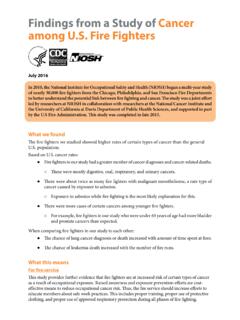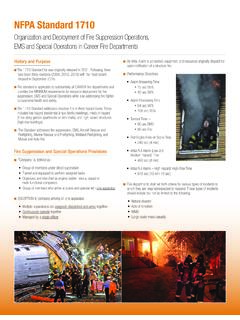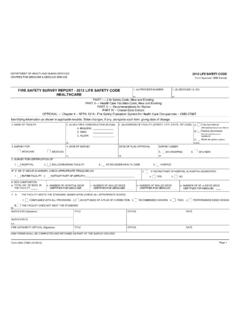Transcription of Fire Protection and Prevention
1 fire Protection and Prevention The Occupational Safety and Health Administration (OSHA) requires employers to implement fire Protection and Prevention programs in the workplace. The regulations that apply to fire Protection and Prevention can be found mainly in Subpart F of the construction standards, though the requirement for a fire Prevention program is first set out in Subpart C. The following sections of the construction standards contain requirements for fire Protection that are of significance to roofing contractors: Subpart C, fire Protection and Prevention programs fire Protection fire Prevention Flammable and combustible liquids Liquefied petroleum gas (LP-Gas) Temporary heating devices Definitions Subpart N, Cranes and derricks Following this chapter, there is a list of fire safety work practices addressing many fire hazards found in the roofing workplace, including field operations and shop activities.
2 Contractors should review the elements of the list most applicable to their companies operations and consider including them in their companies health and safety program. fire Protection fire is a chemical reaction that requires three elements to be present for the reaction to take place and continue. The three elements are: Heat, or an ignition source Fuel Oxygen These three elements typically are referred to as the fire triangle. fire is the result of the reaction between the fuel and oxygen in the air. Scientists developed the concept of a fire triangle to aid in understanding of the cause of fires and how they can be prevented and extinguished. Heat, fuel and oxygen must combine in a precise way for a fire to start and continue to burn.
3 If one element of the fire triangle is not present or removed, fire will not start or, if already burning, will extinguish. Ignition sources can include any material, equipment or operation that emits a spark or flame including obvious items, such as torches, as well as less obvious items, such as static electricity and grinding operations. Equipment or components that radiate heat, such as kettles, catalytic converters and mufflers, also can be ignition sources. Fuel sources include combustible materials, such as wood, paper, trash and clothing; flammable liquids, such as gasoline or solvents; and flammable gases, such as propane or natural gas. Oxygen in the fire triangle comes from the air in the atmosphere.
4 Air contains approximately 79 percent nitrogen and 21 percent oxygen. OSHA describes a hazardous atmosphere as one which is oxygen-deficient because it has less than percent oxygen, or oxygen enriched because it has greater than percent oxygen. Either instance is regarded by OSHA as an atmosphere immediately dangerous to life and health (IDLH) for reasons unrelated to the presence of fire . Depending on the type of fuel involved, fires can occur with much lower volume of oxygen present than needed to support human respiration. Every roofing project has all three of the fire triangle elements present in abundance. The key to preventing fires is to keep heat and ignition sources away from materials, equipment and structures that could act as fuel to complete the fire triangle.
5 fire Classifications Fires are classified as A, B, C, D or K based on the type of substance that is the fuel for the fire , as follows: Class A fires involving ordinary combustibles, such as paper, trash, some plastics, wood and cloth. A rule of thumb is if it leaves an ash behind, it is a Class A fire . Class B fires involving flammable gases or liquids, such as propane, oil and gasoline Class C fires involving energized electrical components Class D fires involving metal. A rule of thumb is if the name of the metal ends with the letters um, it is a Class D fire . Examples of this are aluminum, magnesium, beryllium and sodium. Class D fires rarely occur in the roofing industry. Class K fires involving vegetable or animal cooking oils or fats; common in commercial cooking operations using deep fat fryers fire Extinguishers There are different types of fire extinguishers designed to put out the different classes of fire .
6 Selecting the appropriate fire extinguisher is an important consideration for a roofing contractor. The wrong extinguisher actually may make a fire emergency worse. For example, failing to use a C-rated extinguisher on energized electrical components may endanger workers by causing the extinguishing material to be electrified by the energized components that are on fire . C-rated fire extinguishers put out the fire by using a chemical that does not conduct electricity. The following table illustrates the types of extinguishers, fire classes for which each is used and the limitations of each extinguisher. fire Class of Extinguisher Extinguisher fire it Limitations/ Type Extinguishes Comments Dry Chemical A, B, C Generally good for use in roofing (multipurpose) industry Foam alcohol-resistant B Expensive; effective on Class B only; and aqueous film-forming limited shelf life; generally not foam (AFFF) types needed in roofing industry Water A Good only for Class A fires Metal X D Expensive; must be kept dry; ineffective on A, B, C; typically not needed in roofing industry Carbon Dioxide B, C If used in confined areas, will create oxygen deficiency; not effective in windy conditions; can cause frostbite during discharge; typically not used in roofing industry Halon B, C Expensive.
7 Not effective in windy conditions; toxic gases may be released in extremely hot fires because of decomposition; generally not used in roofing industry Potassium Acetate K Expensive, wet chemical extinguisher for commercial cooking operations using oils and fats Roofing contractors typically purchase dry-chemical fire extinguishers because they can extinguish three fire classes (A, B and C). OSHA requires a minimum-rated 10B fire extinguisher be provided within 50 feet of the point of job site use of more than 5 gallons of flammable or combustible liquids or 5 pounds of flammable gas. Examples of flammable and combustible liquids include gasoline, kerosene, acetone, MEK, single-ply adhesives, splice cleaners and asphalt cutback products.
8 fire extinguishers must be rated by a nationally recognized testing laboratory. Extinguishers also must be inspected on a regular basis and maintained fully charged. Using fire Extinguishers When using fire extinguishers, employees should employ the PASS system of early-stage firefighting. P Pull the pin on the extinguisher A Aim at the base of the fire S Squeeze the handle S -Sweep at the fire , moving from side to side Employees should be instructed that if a fire cannot be extinguished using one full extinguisher, they should evacuate the site and let the fire department handle the situation. fire Prevention fire Prevention requires segregating the three elements of the fire triangle. In practice, a method to achieve that goal is to post and enforce no-smoking signs around flammable liquids and gases and have fire watches on all work involving torch-applied materials of a minimum of two hours after the last torch is turned off.
9 Flammable and Combustible Liquids Proper storage and handling of flammable and combustible liquids will help prevent fires from occurring; only approved, closed containers for storage of flammable or combustible liquids may be used under OSHA rules. Such containers include safety cans or containers approved by the department of Transportation. A safety can is a container that has a self-closing lid, internal-pressure relief and flame arrestor with a capacity of not more than 5 gallons. Inexpensive, plastic cans without those features previously mentioned, such as those typically bought at hardware stores or gas stations, are not approved for use in roofing operations. However, manufacturers do sell plastic containers that meet the OSHA requirements for safety cans.
10 Flammable liquids that are extremely viscous, or difficult to pour, like single-ply adhesive, can be left in their original shipping containers. Similarly, OSHA allows the use of original containers of flammable liquids that are in quantities of one gallon or less. Static electricity may be generated when transferring liquids, gases or solids through pipes or hoses. It is important to dissipate this electric charge when handling flammable and combustible materials. When transferring flammable or combustible liquids from one container to another, the two containers must be bonded together. The bonding process involves attaching a wire with alligator clips on each end to both containers. The clips must penetrate the container coating and touch metal.















